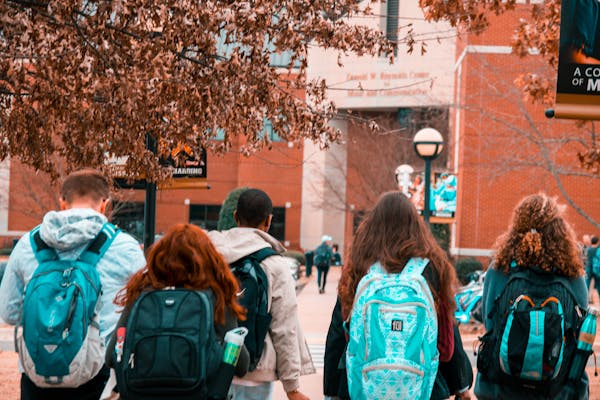
How the Atmosphere of a Classroom Can Change a Student’s Engagement
Aiden SabaterThis article collects “top trends” in higher education that have resulted from the pandemic.
I’m approaching my final semester at San Jose State University with a Bachelor’s in Business Administration with a concentration in Management Information Systems. My collegiate journey consisted of major changes: experiencing community college, transferring to a California State University, meeting various types of professors to get to my final semester of college, and everyone’s favorite: transitioning to online learning. Some of my professors adapted seamlessly from in-person to online, still maintaining the friendly and welcoming atmosphere that was present when we were in-person, while other professors noticeably struggled with the transition. Within this article, I would like to reflect on the different types of classroom atmospheres professors would create and how it affected me.
Allow the students to interact
We have all experienced the awkward silence of a full class before the professor starts lecturing, some even coming in exactly when class begins to avoid it. I have done this plenty of times throughout the duration of my college experience. Despite this, I’ve seen that it only takes one icebreaker for students to begin interacting. I have had many professors utilize class bingo as an icebreaker, but I find this less effective compared to small talk because it is only used on the first day of class. I feel that small talk and more open-ended icebreakers go further when it comes to students consistently interacting with each other. An example of this would be when my professor would spend the first couple minutes of class asking an open-ended question to get the engagement going.
When students feel included, they are more likely to come to class early to spend time with their new friends. Things have changed since classes transitioned to the digital space. Some professors neglected their 5-minute period of introductory conversation since they did not know how to approach it. I became used to arriving on time for my online classes and not any earlier than needed. That was until my professor started using AskClass to share an open-ended question on the screen for the class before the start. It gave students the opportunity to interact freely with a designated topic, comfortably replacing the awkward small talk of trying to get to know someone. This was a moment for professors to assure students that their class would have a welcoming environment.
Create an atmosphere that encourages conversations with students
Professors that create a welcoming atmosphere are more likely to have students reach out to them. It can often feel like a one-way street, where a student always needs to be the first to initiate conversation. It is encouraging when a professor starts the conversation and/or reaches out to students. As a student, I feel less intimidated and more encouraged to participate in a professor’s class or attend office hours when they have created a welcoming atmosphere. An example would be when my professor would ask the class questions such as; “Do you have any plans for the weekend” or “How is your day going?” while setting up their lectures for the class. This fosters an environment where everyone feels equally comfortable to talk and interact, as opposed to awkward silence at the beginning of class that will only be broken by the professor’s lecturing.
Introduction videos
With the transition into online learning, professors have turned to typed introduction posts for students to introduce themselves. Typed introduction posts do help to overcome the initial awkwardness, but they are severely limited. It is hard to convey genuine emotion through text, preventing the reader from feeling any personal connection with them. However, a few professors have assigned introduction videos rather than typed posts, and personally, it is the only way I would like introductions to be assigned for online classes. Such videos offer a personal look into who the student really is, beyond the small static profile picture shown on Canvas. Instead, it provides a real voice, face, and personality that one would otherwise not have with a typed introduction post.
Call on students
It becomes a habit for the same people to consistently participate in class. Fortunately, there are solutions to this. If the regulars continue to answer the professor’s questions, others will become accustomed to allowing them to do so, resulting in a lack of student participation. I myself am guilty of this; I have found that professors that call on students randomly tend to have more focused students. Students become motivated by the fear of being embarrassed in class, resulting in higher levels of class engagement. In an online class of mine, that is exactly what happened. I was so used to the regulars’ answering every question that I became regularly unfocused. That was until the professor began using AskClass to randomly call on people. My classmates and I suffered the consequences of not knowing the answer when called on randomly, and came to the realization that the only solution was to start paying attention and engaging with the content.
The impact of a professor
The experiences I have gained through my collegiate journey so far have prepared me for what I look forward to seeing in my future professors. The impact of my previous professors remains with me, even as I move on to new classes and opportunities. I had changed my major from computer science to Management Information Systems in hopes of finding a more accepting, impactful, and friendly classroom environment, which I fortunately found. Along the way, I had my fair share of different types of professors: STEM, Liberal Arts, and Business. Though each professor had their own different styles of teaching, the best things they did to engage students were the same. They allowed students to interact, created an atmosphere that encouraged conversations with students, utilized introduction posts and videos, and called on students indiscriminately. They were setting students up for success not only within the classroom, but also with each other.
 6 Things We’ve Learned about How the Pandemic Disrupted Learning
6 Things We’ve Learned about How the Pandemic Disrupted Learning
 School’s Out for the Summer and Many Teachers Are Calling It Quits
School’s Out for the Summer and Many Teachers Are Calling It Quits